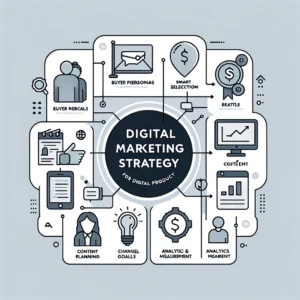Introduction: Emphasizing Product Growth in Product Development
The concept of product growth transcends mere sales figures; it embodies the culmination of strategic planning, quality control, and market responsiveness. This article delves into the nuanced realm of product growth within product development, targeting professionals who seek to refine their strategies in this field. We will explore pivotal practices in product development that directly impact growth, analyze key metrics and KPIs essential for measuring success, and provide insights into exploiting market opportunities effectively. Additionally, we will discuss the challenges faced in this domain and glean expert insights to navigate these hurdles successfully.
The synergy between product development and product growth is undeniable. How a product is developed – from its conception to its market introduction – plays a crucial role in determining its success and longevity in the market. This article aims to equip experts with advanced knowledge and strategies to enhance product growth through informed and effective product development practices.
Understanding Product Development’s Role in Product Growth
Key Practices in Product Development for Optimal Growth
Product development is not just about creating new products; it’s about creating products that grow, evolve, and succeed in the market. Key practices in this area include:
- Market Research and Analysis: Thorough market research lays the foundation for successful product growth. Understanding market trends, customer preferences, and competitor strategies is crucial.
- Innovation and Differentiation: Products that stand out in the market are more likely to experience sustained growth. Innovation in design, functionality, and user experience is key.
- Agile Methodology: Employing agile practices in product development ensures adaptability and responsiveness to market changes, enhancing the product’s growth potential.
- Quality Assurance: Consistent quality is fundamental. It builds brand trust and loyalty, key drivers of product growth.
- Customer Feedback Integration: Regularly incorporating customer feedback into the product development process can significantly enhance the product’s market fit and growth trajectory.
The Interplay Between Product Development and Market Success
The success of a product in the market is intrinsically linked to its development process. A product that is well-researched, innovatively designed, and aligned with customer needs is more likely to achieve sustained growth. This section will analyze how effective product development strategies directly influence market success, including examples of products that have successfully leveraged these strategies for growth.
Metrics and KPIs for Measuring Product Growth
Profit Growth as a Metric for Success
Profit growth remains a primary indicator of a product’s success in the market. It’s essential to understand that profit growth should be contextualized:
- Relative-Profit Growth: This involves assessing the profit growth of a company against its sector’s average. It provides a clear picture of how the product is performing relative to its competitors.
- Profit-Growth Stability: This metric evaluates the consistency of profit growth over a period, usually a decade. Stability in profit growth indicates a sustainable and resilient product strategy.
Quality and Impact-Related KPIs in Product Development
In addition to financial metrics, several qualitative KPIs play a crucial role in assessing product growth:
- User Satisfaction: This KPI measures how well a product meets customer expectations, a direct predictor of customer loyalty and repeat business.
- Defect Rate: The rate of defects in a product can significantly impact its market performance and growth. A lower defect rate is indicative of higher product quality.
- Revenue Growth from Product: This metric tracks the direct revenue generated from the product, providing insight into its market success.
- Market Penetration and Share: Understanding how much of the market a product has captured helps in gauging its growth and planning future strategies.
Next, we will delve into how new product development can be optimized to exploit market opportunities effectively.
Exploiting Market Opportunities Through Product Development
Aligning Product Development with Customer Needs and Wants
In the realm of product development, aligning with customer needs and wants is not just a strategy; it’s a necessity for achieving significant product growth. This alignment is an ongoing process, requiring continuous adaptation and innovation. It involves several key steps:
- In-Depth Customer Insights: The first step in aligning product development with customer needs is to gain a deep understanding of your target audience. This involves extensive market research, including surveys, focus groups, and analysis of customer data. Understanding customer behavior, preferences, and pain points is crucial for developing products that meet their needs.
- Implementing Feedback Loops: Robust feedback mechanisms are essential for continuous improvement. This can be achieved through customer surveys, reviews, and direct feedback channels. The goal is to create a loop where customer feedback directly influences product development, ensuring that the product evolves in line with customer expectations.
- Customization and Personalization: Offering customization options or developing products that cater to specific customer segments can significantly enhance a product’s appeal. Personalization can range from simple aesthetic choices to complex functional adaptations based on user behavior.
- Predictive Analytics for Future Needs: Leveraging data analytics and AI to predict future customer trends can give a product a competitive edge. By anticipating changes in customer preferences, companies can innovate proactively, keeping their products relevant and desirable.
- Agility in Product Development: The ability to quickly respond to market changes is a key factor in successful product growth. Implementing agile methodologies in product development allows for rapid iteration and adaptation, keeping the product aligned with current market demands.
Case Studies: Successful Market Exploitation via Product Development

Google’s Innovative Approach
Google’s journey from a simple search engine to a global tech giant showcases a product development strategy centered around innovation and user focus. The company’s guiding principles include focusing on user needs, pursuing radical improvement (a 10x improvement approach), and launching products early to iterate based on feedback. This approach has led to the development of a wide range of successful products and services like Gmail, YouTube, Android OS, and Chrome.
Amazon’s Customer-Centric Model
Amazon, starting as an online bookstore, evolved into a massive online marketplace and cloud computing giant. The core of Amazon’s product development is the “working backward” method, where product development begins with the customer experience. This strategy involves writing a press release before starting development to focus on customer needs and problems the product will solve. This customer-first approach has been instrumental in Amazon’s expansion and success.
Netflix’s Focus on Consumer Science
Netflix transformed from a DVD rental service to the world’s leading streaming platform. Their product development process is rooted in consumer science, involving constant experimentation, testing, and learning from real user interactions. The company places a strong emphasis on personalization, using AI and machine learning to tailor user experiences, which has significantly boosted user engagement and retention.
Zoom’s Adaptability and Customer Focus
Zoom, a cloud-based conferencing tool, exemplifies adaptability and customer focus in product development. Founded to offer a simple and effective video conferencing solution, Zoom’s product-led growth strategy and its freemium model have significantly contributed to its widespread adoption. Additionally, Zoom’s flexibility in responding to changing market conditions, especially during the COVID-19 pandemic, has been crucial to its success.
These case studies illustrate how successful product exploitation in the market can be achieved through innovative approaches, customer-centric models, a focus on user experience, and adaptability to market changes. Each of these companies has demonstrated how aligning product development with market opportunities and customer needs can lead to significant growth and market leadership.
Navigating Common Challenges in Product Development for Growth
Insights from Product Development Professionals
In the journey of product development, professionals often encounter a myriad of challenges that can impede growth. Understanding these challenges and how to navigate them is crucial. This section will explore insights from seasoned product development professionals, focusing on common issues such as:
- Balancing Innovation with Feasibility: Often, the drive for innovation can clash with practical constraints like budget, resources, or technology limitations. Experts discuss strategies for striking a balance between ambitious innovation and realistic execution.
- Managing Rapid Market Changes: The market can evolve quickly, rendering a product outdated or irrelevant. Professionals share their experiences on staying agile and responsive to market dynamics.
- Ensuring Product-Market Fit: One of the biggest challenges is ensuring that a product meets market demands. This part will delve into methods for continuous market analysis and adaptation to maintain product-market fit.
- Dealing with Competition: In a saturated market, standing out against competitors is a significant challenge. Experts offer insights into differentiating products and creating a unique value proposition.
Addressing and Overcoming Key Issues in Product Development
This section will provide practical solutions and strategies to overcome the challenges identified above, drawing from real-world experiences and case studies. It will cover aspects such as:
- Effective Resource Allocation: Optimizing the use of resources to maximize innovation and product development efficiency.
- Adopting Flexible Development Methodologies: Implementing agile or hybrid methodologies to adapt to changing market needs rapidly.
- Customer-Centric Approach: Emphasizing the importance of continuous customer feedback and engagement in shaping product development.
- Strategic Market Positioning: Techniques for positioning products in a way that leverages market gaps and capitalizes on emerging trends.
By the end of this section, readers will have a comprehensive understanding of the common challenges in product development for growth and actionable insights on how to address them effectively.
Conclusion: Synthesizing Key Takeaways for Product Growth in Development
As we conclude this exploration of product growth in the context of product development, it’s clear that the journey is multifaceted, requiring a blend of innovation, customer-centric strategies, and agility. Key takeaways include:
- The Importance of Alignment with Customer Needs: Successful products stem from a deep understanding of and alignment with customer preferences and market demands.
- Innovation and Responsiveness: Continuous innovation and responsiveness to market changes are crucial for sustaining product growth.
- Navigating Challenges Strategically: Addressing common challenges in product development with strategic planning and execution is vital for achieving growth.
- Learning from Success Stories: Real-world case studies of Google, Amazon, Netflix, and Zoom provide valuable lessons in leveraging market opportunities through effective product development.
The landscape of product development is ever-evolving, and staying ahead requires a commitment to learning, adaptation, and strategic execution. This article aimed to provide experts with insights and strategies to enhance product growth through informed product development practices. The future of product development is bright with opportunities for those ready to embrace these challenges and innovate continuously.




